Koshi Garuma To Ouchi Gari - Angie Delgado
If you haven’t heard of Angie Delgado yet, you’re about to know her name as familiarly as the best professional athletes you follow. Angie is the number 1 ranked athlete in the United States in Judo. THE number one, meaning she currently outranks all other male and female athletes in the US! As if that weren’t enough, Angie competed in the 2016 Olympics and represented the US in the 52kg category. If her accolades didn’t speak highly enough about her, wait until you see what she can do on the mats. Her specialty is The Koshi Garuma to Ouchi Gari.
In this video, Angie describes and executes one of her favorite combinations: Koshi Garuma to Ouchi Gari. Watch once first all the way through, and then re-watch to really grasp all of the details she throws into this combo. Much like a refined palate can pick out the initial taste of food, and goes back for a second bite for the equally important undertones profiles of the dish; this combination is packed with flavor and personality. Speaking of food, among the many things Angie does well, eating right is right up there with them. As a fighter, what you fuel your body with is of utmost importance. Without further ado, let's get started!
A Career in Sales
In this combination, a successful result relies on real commitment from both players. That means that the assailant (in this case, Angie) has to really sell and attempt the first throw, as if it were her true aim (the first throw referring to the Koshi Garuma). Once Angie sells it, her partner (in this case, Adonis, also a number 1 ranked US athlete in the 60kg division) has to give her a real reaction in defending the forward throw.
Newton’s Laws of Motion
Let’s take a brief moment here to throw it back to high school science class. Whether or not you paid attention to them, Newton’s Laws of Motion are in play whenever we are. In this case, the best example is Newton’s Third Law. Simply put: For every action, there is an equal and opposite reaction. Angie cites this law in the video (looks like she paid attention in science class) and it is a really fitting description for what she is doing.
The Breakdown
By selling the first throw, she’s able to get an equal and opposite reaction out of Adonis, that reaction is what allows her to execute the Ouchi Gari using Adonis’ reaction against him. How does she do this so well? And what can you take away from this step-by-step? We’re glad you asked!
Step 1 Koshi Garuma to Ouchi Gari:
First and foremost, you have to make a committed first throw, which forces your opponent to block. Your ability to sell this throw, and their subsequent reaction, is what sets up a successful Ouchi Gari. Without you selling the Koshi Garuma, the Ouchi Gari doesn’t happen. This combination can be deadly to your opponent, but you have to set it up right.
Step 2 Koshi Garuma to Ouchi Gari:
Once you’ve sold the Koshi Garuma and your opponent takes the bait, take a step and pivot back into them and get your head close to theirs. It is very important that your head is on the opposite side as the leg you are reaping, so pay very close attention to your head placement when you spin back into your opponent.
Step 3 Koshi Garuma to Ouchi Gari:
Now the fun part: Sweep the leg! Keep contact and maintain pressure on your opponent’s chest through the duration of the sweep. Angie sticks to Adonis like glue in this video, not giving an inch and doing everything she can to support the work she just did.
Step 4 Koshi Garuma to Ouchi Gari:
Your landing is critical, by ensuring you land smoothly and maintain that chest pressure on your opponent, you give yourself the best chance at staying in control and finishing the job. It’d be foolish to not take advantage of a well-executed combination like this, the easiest way to lose it at the last moment (and you better believe it is easy) is to forget to maintain chest pressure on your opponent. Don’t make that mistake!
Combination throws are underutilized and vastly underestimated skills. When doing judo, it’s extremely important to have a super strong arsenal of combination throws. How many times have you been doing judo and felt like your opponent knew each and every move you were throwing at them? With a well-executed combination, you can trick your opponent and rack up scores, and find a way to win.
Misdirection and Trickery
Misdirection is sometimes the best way to get scores. Really selling throws, tricking your opponent and catching them off guard is the way to do it. Angie does a great job misdirecting Adonis into thinking she is fully committing to a forward direction. Little does Adonis know, she has no intention on carrying out the full Koshi Garuma. Adonis plays a strong defense, which is just what Angie wanted (and needed) and by the time she shifts her momentum and transitions into the Ouchi Gari, it is too late for Adonis and Angie scores with her backward technique.
A Final Thought
The cool part about combinations is that they can be unique to the individual. While most combinations have been tried and experimented with, you get to decide which works for you and which ones you can really sell and score with. So get off the internet, get to the mats, and try a few out! Let us know how they go.
--- Watch Below ---
How to defend an armlock from a judo player
Sometimes the best defense is a good offense."
Trap Juji
The Trap Juji shown here should only be used when you feel your opponent hanging onto your arm, but not trying to finish. The battle is still ongoing and your opponent is looking to render you incapacitated, but not defeated...yet. As you get more experience with a Trap Juji you will begin to notice when you should be attacking vs. defending. This is an important distinction because you can toy with your opponent the same way they're doing to you. But definitely play around with this in order to be super comfortable reading your opponent from the position. Defending an armlock from a judo player can be simple, as long as you know what to expect. If your goal is to win (and it probably should be), remember to play a solid defense first, and then look to attack second.
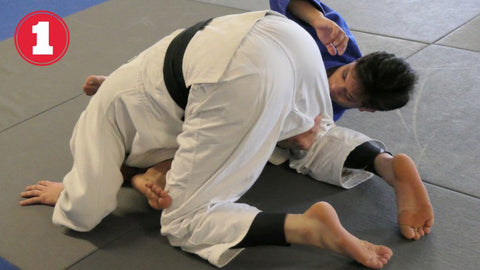
Trap Juji Step 1:
Jack Hatton sets up a solid foundation and a great wide base here. In this act of defense with a wide base, he essentially forces his opponent to reach across. This allows him to transition from defending to attacking.
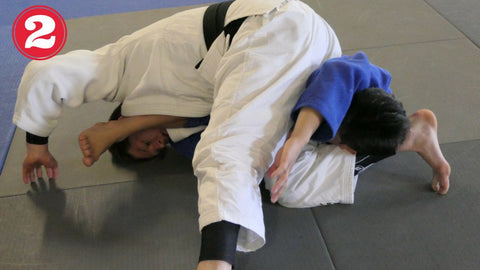
Trap Juji Step 2:
As soon as the reach happens, Jack is on attack mode. He uses his body to incapacitate his opponent and transitions into being in control.
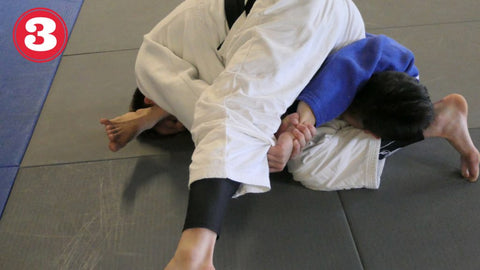
Trap Juji Step 3:
With his opponent trapped, Jack capitalizes on the end result of the reach he forced in step 1. He grips his opponent's reaching arm and is in full attack mode.
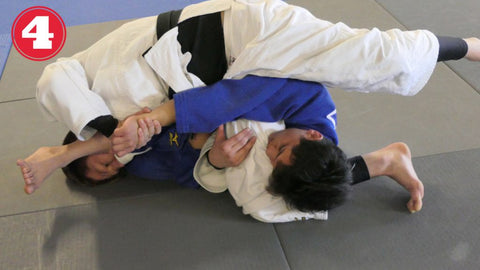
Trap Juji Step 4:
With his opponent's arm gripped, Jack is in control and shifts back to pull his opponent's arm between his legs to finish the lock. He's got to be strong to accomplish this.
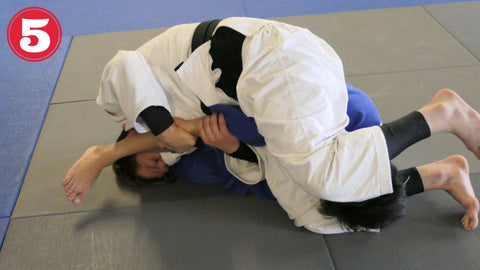
Trap Juji Step 5:
Jack settles into an armlock of his own. He shifted from defend to attack and in the transition put himself in an advantageous position to score and even win. This is how defending an armlock from a judo player should look. Take note!
Final Thoughts
The foundation of this defense method is a having a solid base. If you make yourself heavy, your job becomes much much easier. And ultimately, that wide base maintained is the key to getting your opponent to reach across and give you the best opportunity to go from defending to attacking. Once they make a commitment to reaching across you, then you can begin to set the Trap Juji and find that balance. Following is a step by step explanation of some key components of the armlock defense and Trap Juji. Let us know how it works for you!
--- Watch Below ---
Learn Uchimata with 3x Olympian Travis Stevens & US National Champion Alisha Galles
Uchimata is one of the most spectacular throws in Judo. Don't believe us? Ask Alisha Galles, US National Champ in 63kg division. This technique makes for some of the best highlight reel footage when browsing YouTube. In fact, the general population probably thinks of uchimata (unbeknownst to them) every time they think of judo throws. Yep. That popular.
In this video, 3x United States Olympian Travis Stevens teams up with 63kg US National Champ Alisha Galles to show you her version of Uchimata. While basic, Alisha's version is still extremely effective in competition. Evidenced by her US champion title.
Take a look and learn uchimata from this dream team duo. They break it down into bite size pieces to help us out with comprehension. Remember, no matter what age, weight division, or gender you are, you can always learn uchimata and use it in competition. Whatever your preferred version is, just make sure it works for you!
Uchimata is one of the most spectacular throws on the IJF Circuit!"
The Breakdown
- The best grip for Alisha's version of this throw is pretty basic but super effective. She has a hand on her opponent's collar and locks down on the sleeve with her other hand, "killing" the sleeve. This ensures that her opponent's hand cannot come up.
- Her opponent's struggle to raise that hand will allow Alisha to pull and knock her opponent off-balance. Making it easier for her to step into her opponent.
- With Alisha's pulling arm, she keeps her elbow higher than her shoulder, creating a bunch of space for her to creep into her opponent and control them.
- Use your best uchimata footwork to finish the throw!
A Final Thought
Everyone has their own version of uchimata. Travis and Alisha are both seasoned veterans in this throw. Being proficient in uchimata (amongst many others) is just one of the skills you'll learn at the team USA training location, Pedro's Judo Center in Wakefield, MA.
The best part of uchimata, aside from it being an awe-inspiring spectacle, is how accessible of a spectacle it can be. While not necessarily easy to learn, there are ways to make it your own and make it work for you and your style of judo.
Learning from Travis and his team is a great opportunity to improve your judo! Have some fun and let us know how it goes!


